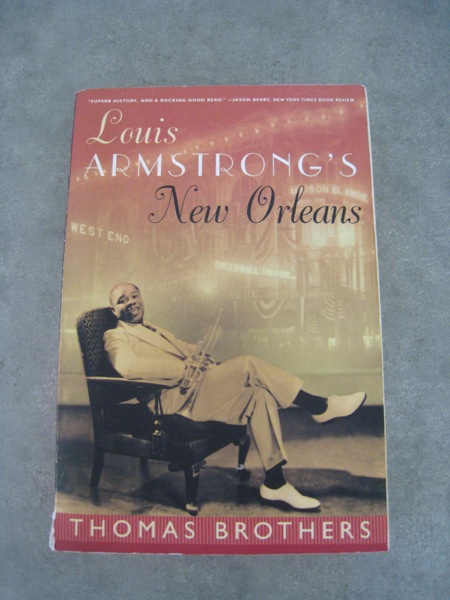Thomas Brothers Louis Armstrong's New Orleans

As we get older it’s fair to say our perception of time changes and we realise events we’ve long regarded as belonging to the dim dark distant past weren’t really that long ago.
As the days, weeks and months merge into each other those halcyon days in the late sixties don’t seem so long ago, and when I paused to reflect on such matters recently I noted that my parents would have memories back to the other side of World War Two and the Great Depression. My grandparents would have seen the events of the First World War unfold and their parents would have been around to see the Australian Federation come into existence.
Which would make them more or less contemporaneous with Louis Armstrong, whose grandparents would have been born some time around the end of the American Civil War, an event that always seemed to be wrapped up in the mists of Antiquity when I was much younger.
Looking at it that way the past doesn’t seem so distant at all.
The massive social upheavals following the end of the Civil War, as Thomas Brothers’ Louis Armstrong’s New Orleans makes quite clear, created the environment where a number of musical influences intertwined to produce jazz and change the musical landscape around the world.
To some, that would be an absurdly grandiose proposition, but when you look at contemporary music it would be a completely different environment without the influence of a fifth-grade dropout and serious truant whose earliest musical influences came from the streets, churches, honky tonks and brothels of uptown New Orleans, the neighbourhoods where tens of thousands of ex-slaves relocated during the shakeout that came with and followed Abolition and Reconstruction.
The urban environment to which they relocated was. unsurprisingly in the light of the times, marked by racial tensions. Volatile interactions between blacks and whites were further complicated by a substantial Creole population, largely free people of color who had owned slaves before the Civil War. After Reconstruction, Jim Crow laws meant that Creoles found themselves relegated to the same segregated status as former slaves and their children.
At the same time New Orleans was a city of music, with funeral bands marching through the streets, past the dance halls and cabarets where professional Creole reading musicians played popular tunes of the day, as well as the street corners and honky-tonks where early blues musicians plied their trade late into the night.
As Brothers follows Armstrong through the cultural terrain in which he matured he goes to some length to identify strands that became interwoven into what we would recognize as jazz. He traces the influence of European hymns and the way they were transformed inside the Sanctified Church, acknowledges the role played by rag collectors who announced their presence in the neighbourhood by blowing toy horns and points out Armstrong’s early participation in vocal quartets as well as discussing the role played by brass bands with their funeral processions of second liners.
Those elements in themselves would arguably have been enough to create new musical forms reflecting a new urban identity for black migrants from rural areas, good-time music often played out of doors that was built around improvisation as musicians interacted with their audience.
As he moved unsupervised through the city’s streets, stomping his feet in church, peeking through the windows at the dirty dancing in places like the Funky Butt Hall, and marching in the second line that followed the parade bands up and down Canal Street, Armstrong absorbed the same influences as many of his contemporaries.
The time he spent in the Coloured Waifs Home aged eleven and twelve brought his first cornet and a grounding in musical technique. Lessons from his mentor "King" Oliver, who called him to Chicago in 1922, the time he spent playing on riverboats (learning musical notation along the way) and further lessons from his classically trained second wife built on that background and Armstrong’s own musical curiosity, resulting in performances that redefined jazz.
There’s no doubt that the music that came to be known as jazz grew out of a number of elements and there will probably be endless debate about the relative influence of the various strands.
The sequence outlined above - the streets to the Coloured Waifs home to more formal musical training puts Brothers on the uptown side of the fence, and he discounts the influence of downtown Creole musicians, arguing that their more formal background limited their ability to improvise.
There’s no doubt that the music that has come out of New Orleans is the result of an unique blend of influences and that Armstrong ties together the strands that ran through the city’s social and musical history in the late nineteenth and early twentieth centuries.
Brothers has drawn on autobiographies, interviews and memoirs to produce a book that should be of interest to anyone with an interest in the musical culture of New Orleans. The more technical discussions prompted me to skim sections of the book, but the wealth of information included was enough to make sure that I didn’t put it aside and I expect that it’s one of those volumes that’ll be re-read from time to time as I explore different aspects of New Orleans music.

